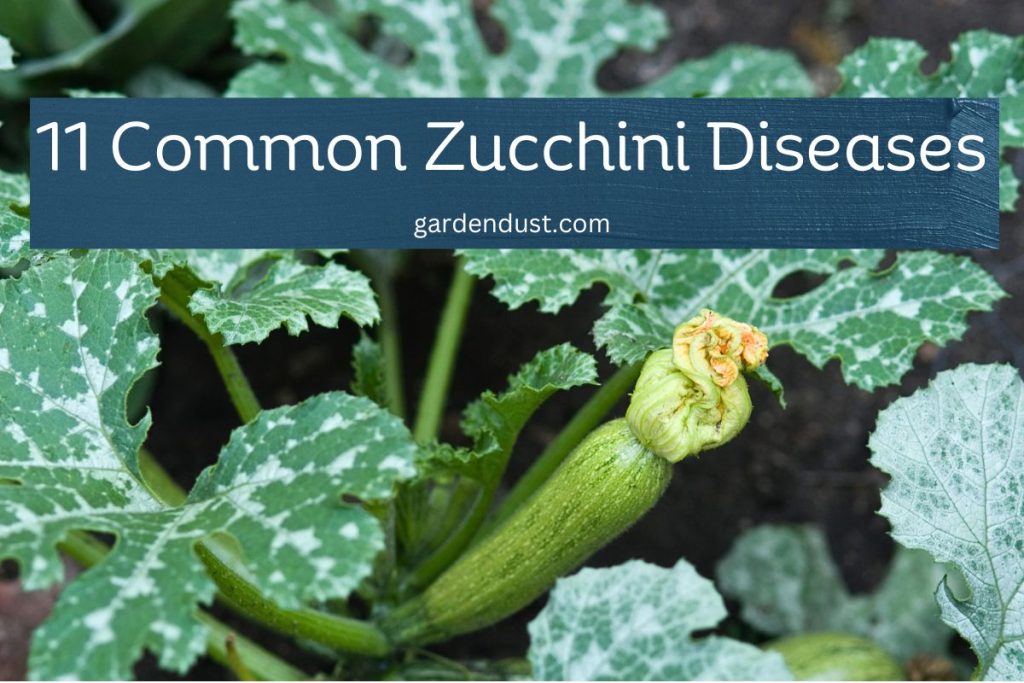Zucchini, with its vibrant green color and versatile culinary applications, is a cherished addition to many gardens and kitchens. However, the journey from seed to harvest is not without its challenges, as zucchini plants are susceptible to various diseases that can compromise their health and yield. In this in-depth exploration, we unravel the intricacies of 11 Common Zucchini Diseases affecting zucchini, shedding light on their causes, symptoms, and effective preventive and management strategies. By understanding these adversaries, gardeners and enthusiasts can arm themselves with the knowledge needed to cultivate robust and thriving zucchini crops. Let’s start…
Common Zucchini Diseases –
1.Powdery Mildew
Powdery Mildew, caused by various fungi, is a prevalent disease affecting zucchini plants. It presents as a white, powdery substance on the leaves, stems, and even fruits. This fungal infection inhibits photosynthesis, leading to stunted growth and reduced yield. To combat Powdery Mildew, growers can adopt cultural practices such as proper spacing to enhance air circulation, selecting mildew-resistant varieties, and applying fungicidal treatments early in the growing season. Neem oil and potassium bicarbonate-based sprays are effective organic alternatives for managing Powdery Mildew.
2.Downy Mildew
Downy Mildew, caused by the oomycete pathogen Pseudoperonospora cubensis, manifests as yellow angular lesions on the upper leaf surface with corresponding grayish-brown fungal growth on the undersides. This disease can rapidly spread, leading to defoliation and a decline in zucchini yield. Effective management involves selecting Downy Mildew-resistant varieties, practicing crop rotation, and applying copper-based fungicides preventatively. Regular monitoring and early intervention are essential for controlling Downy Mildew and minimizing its impact on zucchini crops.
3.Blossom End Rot
Blossom End Rot is a physiological disorder rather than a true disease, characterized by the development of dark, sunken lesions on the blossom end of zucchini fruits. This condition is often associated with calcium deficiency, inconsistent watering, or imbalances in soil moisture. To prevent Blossom End Rot, gardeners should maintain consistent watering practices, ensure proper soil calcium levels through amendments, and avoid over-fertilizing with nitrogen, which can interfere with calcium uptake. Mulching can also help regulate soil moisture and reduce the risk of Blossom End Rot.
4.Zucchini Mosaic Virus
The Zucchini Mosaic Virus (ZYMV) is a viral pathogen transmitted by aphids, cucumber beetles, and infected seeds. Infected zucchini plants display mosaic-like patterns on leaves, yellowing, stunted growth, and distorted fruits. Preventive measures include using virus-free seeds, employing reflective mulches to deter aphids, and introducing natural predators of aphids. Practices such as crop rotation and removing infected plants promptly can help manage ZYMV. However, there is no cure for viral infections, making prevention and early detection crucial.
READ ALSO:-15 Common Cabbage Problems
5.Fusarium Wilt
Fusarium Wilt, caused by the soil-borne fungus Fusarium oxysporum, results in wilting, yellowing, and eventual death of zucchini plants. This pathogen attacks the vascular system, disrupting water and nutrient transport. Prevention involves selecting Fusarium-resistant varieties, practicing crop rotation, and ensuring proper soil drainage. Additionally, using disease-free seeds and avoiding planting zucchini in areas with a history of Fusarium Wilt can mitigate the risk of infection.
6.Anthracnose
Anthracnose, caused by the fungus Colletotrichum orbiculare, affects zucchini plants by causing dark, sunken lesions on leaves, stems, and fruits. Warm and humid conditions promote the spread of Anthracnose. Effective management strategies include using disease-resistant zucchini varieties, practicing proper spacing for adequate air circulation, and applying copper-based fungicides preventatively. Regular pruning of affected plant parts and proper disposal of infected debris can also help control Anthracnose.
7.Gray Mold
Gray Mold, caused by the fungus Botrytis cinerea, is a common disease affecting zucchini during periods of high humidity. It manifests as fuzzy, grayish-brown fungal growth on leaves, flowers, and fruits. Cultural practices such as spacing plants adequately, promoting good air circulation, and avoiding overhead irrigation help mitigate the risk of Gray Mold. Removing and destroying infected plant material, especially in the post-harvest period, is crucial for preventing the spread of spores. Organic fungicides containing sulfur or copper can be applied as preventive measures.
8.Root Rot
Root Rot, often caused by soil-borne pathogens like Phytophthora spp. or Rhizoctonia spp., affects the roots of zucchini plants, leading to wilting, yellowing, and eventual plant death. Improving soil drainage, practicing crop rotation, and avoiding overwatering are essential preventive measures against Root Rot. Using disease-resistant zucchini varieties and applying fungicides containing beneficial microbes can also help manage the disease. Careful inspection of roots and prompt removal of infected plants contribute to effective Root Rot control.
9.Angular Leaf Spot
Angular Leaf Spot, caused by the bacterium Pseudomonas syringae pv. zucchini, results in water-soaked lesions with a characteristic angular appearance on zucchini leaves. The lesions may turn brown and lead to defoliation. Preventive measures include using disease-free seeds, practicing crop rotation, and avoiding overhead irrigation. Copper-based bactericides can be applied as a preventive measure during periods of high humidity. Proper spacing and maintaining good garden hygiene help minimize the risk of Angular Leaf Spot.
10.Septoria Leaf Spot
Septoria Leaf Spot, caused by the fungus Septoria cucurbitacearum, manifests as small, circular lesions with dark centers and yellow halos on zucchini leaves. This disease can lead to premature defoliation and reduced fruit yield. Management involves practicing crop rotation, applying fungicides containing copper or sulfur, and ensuring proper spacing for air circulation. Removing and destroying infected leaves, especially those at the bottom of the plant, helps reduce the spread of spores. Regular monitoring and early intervention are crucial for effective Septoria Leaf Spot control.
11.Cucumber Mosaic Virus
Cucumber Mosaic Virus (CMV) is a viral pathogen that affects zucchini plants, causing mosaic patterns on leaves, yellowing, and stunted growth. Aphids transmit CMV, emphasizing the importance of controlling aphid populations. Prevention involves using virus-free seeds, employing reflective mulches to deter aphids, and introducing natural predators. Removing and destroying infected plants, especially during the early stages of infection, helps prevent the spread of CMV. There is no cure for viral infections, making preventive measures and early detection critical.
As devoted gardeners and zucchini enthusiasts, understanding and effectively managing common diseases is essential for cultivating healthy and productive crops. By adopting preventive measures, practicing vigilant monitoring, and implementing timely interventions, growers can minimize the impact of these diseases on their zucchini plants. Whether it’s fungal infections, viral diseases, or physiological disorders, a proactive approach is the key to ensuring a bountiful harvest of this beloved summer squash. Armed with knowledge and a commitment to plant health, gardeners can navigate the challenges posed by zucchini diseases and enjoy the rewards of a thriving garden. Happy Gardening…







